Strategy Management: Applying Theory to Blackberry's Challenges
VerifiedAdded on 2023/03/31
|22
|4817
|380
Case Study
AI Summary
This assignment provides a comprehensive analysis of strategy management, starting with an examination of Mintzberg's model and its implications for different roles within an organization, including the CEO, top managers, internal consultants, middle line managers, and external management consultants. It further evaluates McKinsey & Company's employee training program. The assignment then delves into design thinking and ambidextrous organizations, exploring their relevance in contemporary business environments. A significant portion of the work is dedicated to a case study of Blackberry, analyzing its external environment, key trends in the smartphone industry, its corporate strategy, market share, financial position in 2016, and top management team. A SWOT analysis is conducted to identify potential growth opportunities and provide recommendations for Blackberry's future strategy, considering the impact on shareholders and stakeholders. The assignment concludes by emphasizing the importance of strategic adaptation and innovation for organizational success. Desklib provides a platform for students to access similar solved assignments and past papers.
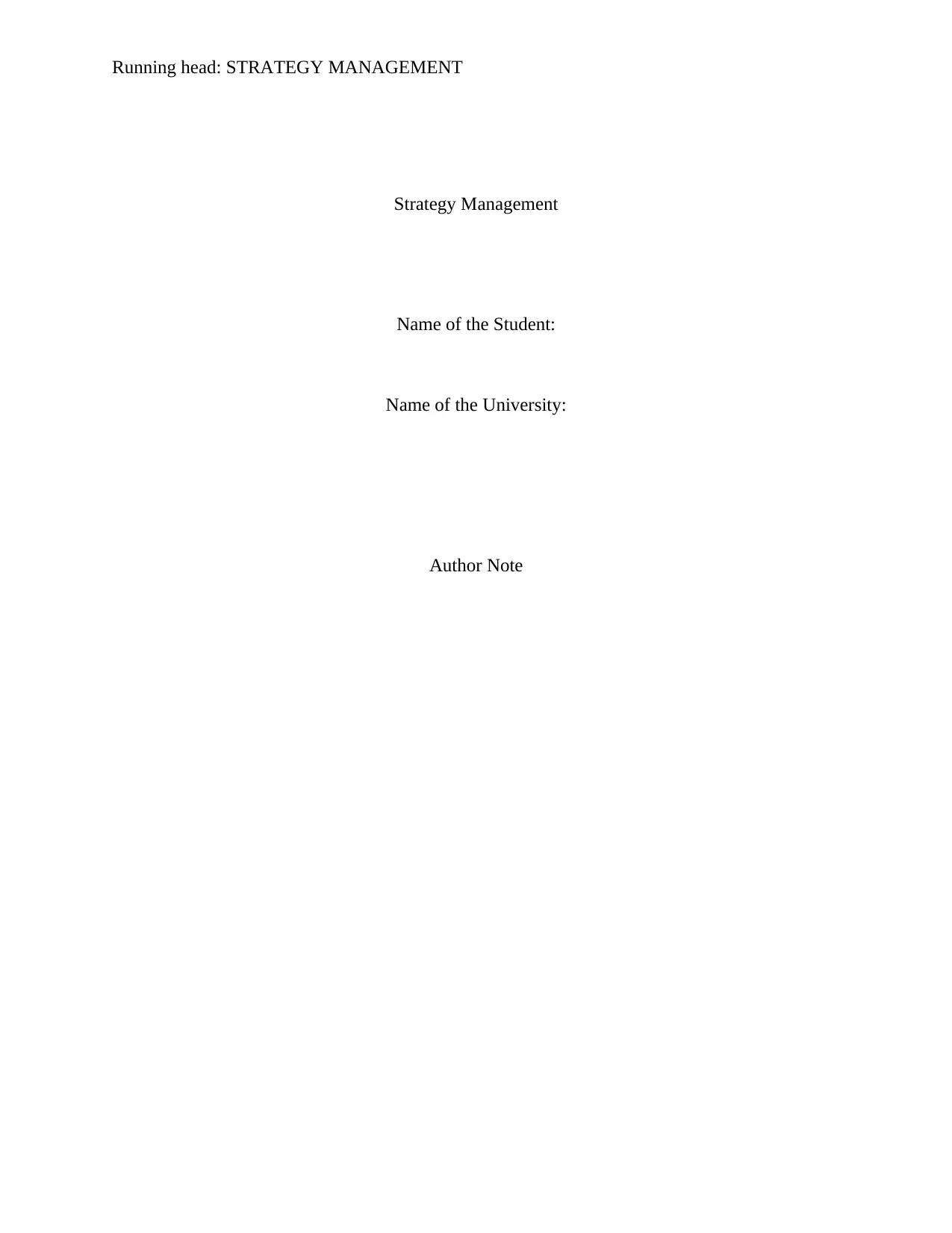
Running head: STRATEGY MANAGEMENT
Strategy Management
Name of the Student:
Name of the University:
Author Note
Strategy Management
Name of the Student:
Name of the University:
Author Note
Paraphrase This Document
Need a fresh take? Get an instant paraphrase of this document with our AI Paraphraser
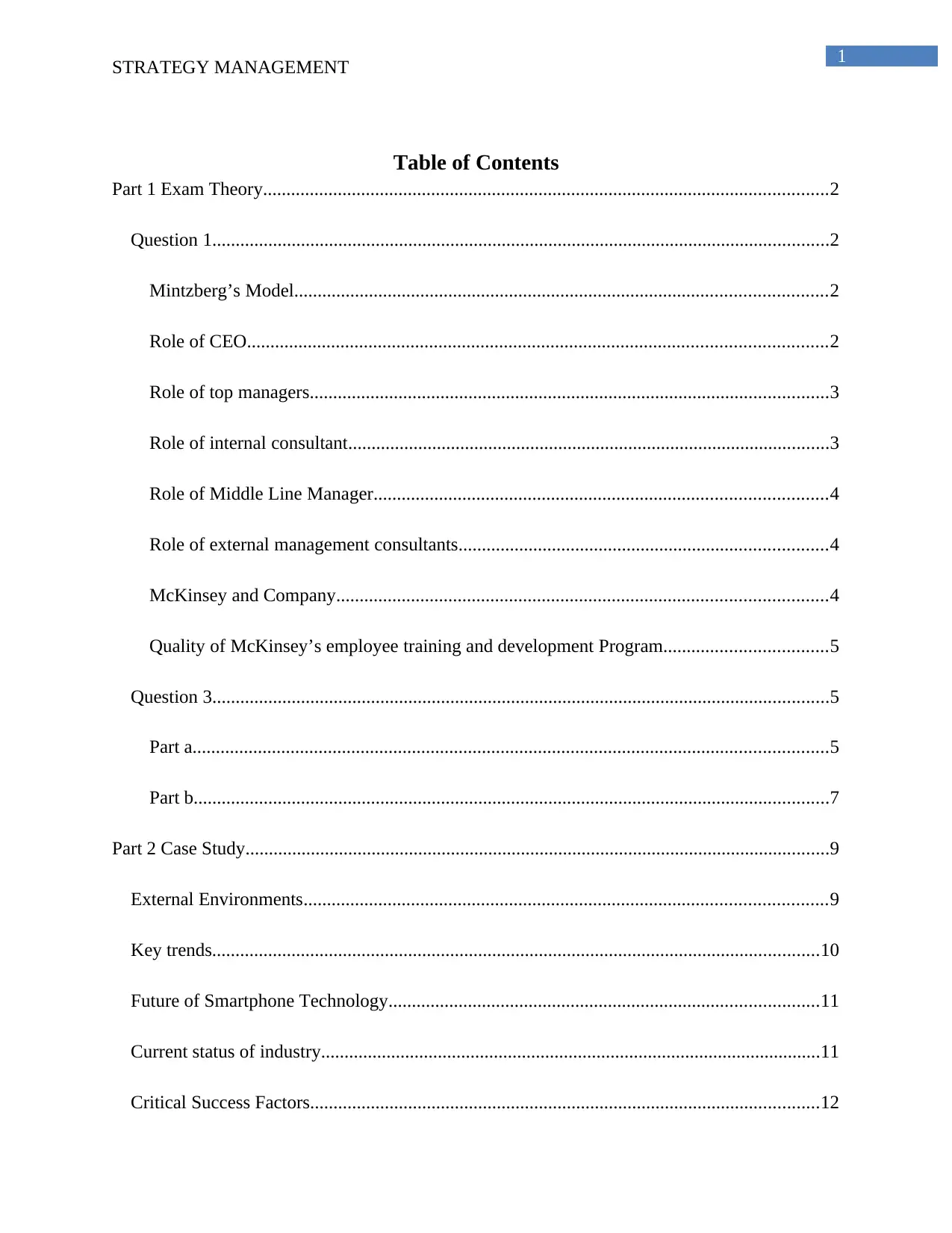
1
STRATEGY MANAGEMENT
Table of Contents
Part 1 Exam Theory.........................................................................................................................2
Question 1....................................................................................................................................2
Mintzberg’s Model..................................................................................................................2
Role of CEO............................................................................................................................2
Role of top managers...............................................................................................................3
Role of internal consultant.......................................................................................................3
Role of Middle Line Manager.................................................................................................4
Role of external management consultants...............................................................................4
McKinsey and Company.........................................................................................................4
Quality of McKinsey’s employee training and development Program...................................5
Question 3....................................................................................................................................5
Part a........................................................................................................................................5
Part b........................................................................................................................................7
Part 2 Case Study.............................................................................................................................9
External Environments................................................................................................................9
Key trends..................................................................................................................................10
Future of Smartphone Technology............................................................................................11
Current status of industry...........................................................................................................11
Critical Success Factors.............................................................................................................12
STRATEGY MANAGEMENT
Table of Contents
Part 1 Exam Theory.........................................................................................................................2
Question 1....................................................................................................................................2
Mintzberg’s Model..................................................................................................................2
Role of CEO............................................................................................................................2
Role of top managers...............................................................................................................3
Role of internal consultant.......................................................................................................3
Role of Middle Line Manager.................................................................................................4
Role of external management consultants...............................................................................4
McKinsey and Company.........................................................................................................4
Quality of McKinsey’s employee training and development Program...................................5
Question 3....................................................................................................................................5
Part a........................................................................................................................................5
Part b........................................................................................................................................7
Part 2 Case Study.............................................................................................................................9
External Environments................................................................................................................9
Key trends..................................................................................................................................10
Future of Smartphone Technology............................................................................................11
Current status of industry...........................................................................................................11
Critical Success Factors.............................................................................................................12
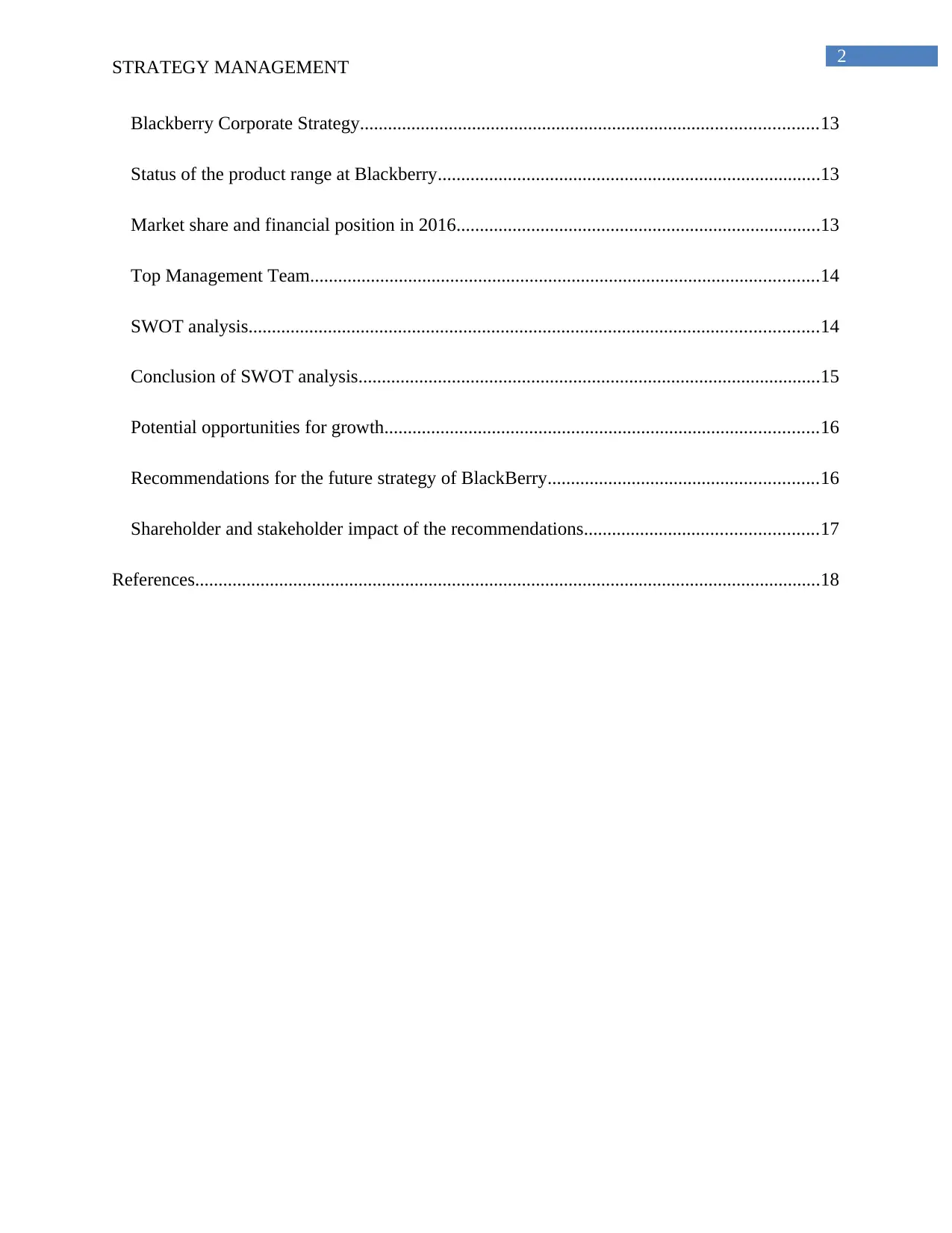
2
STRATEGY MANAGEMENT
Blackberry Corporate Strategy..................................................................................................13
Status of the product range at Blackberry..................................................................................13
Market share and financial position in 2016..............................................................................13
Top Management Team.............................................................................................................14
SWOT analysis..........................................................................................................................14
Conclusion of SWOT analysis...................................................................................................15
Potential opportunities for growth.............................................................................................16
Recommendations for the future strategy of BlackBerry..........................................................16
Shareholder and stakeholder impact of the recommendations..................................................17
References......................................................................................................................................18
STRATEGY MANAGEMENT
Blackberry Corporate Strategy..................................................................................................13
Status of the product range at Blackberry..................................................................................13
Market share and financial position in 2016..............................................................................13
Top Management Team.............................................................................................................14
SWOT analysis..........................................................................................................................14
Conclusion of SWOT analysis...................................................................................................15
Potential opportunities for growth.............................................................................................16
Recommendations for the future strategy of BlackBerry..........................................................16
Shareholder and stakeholder impact of the recommendations..................................................17
References......................................................................................................................................18
⊘ This is a preview!⊘
Do you want full access?
Subscribe today to unlock all pages.

Trusted by 1+ million students worldwide
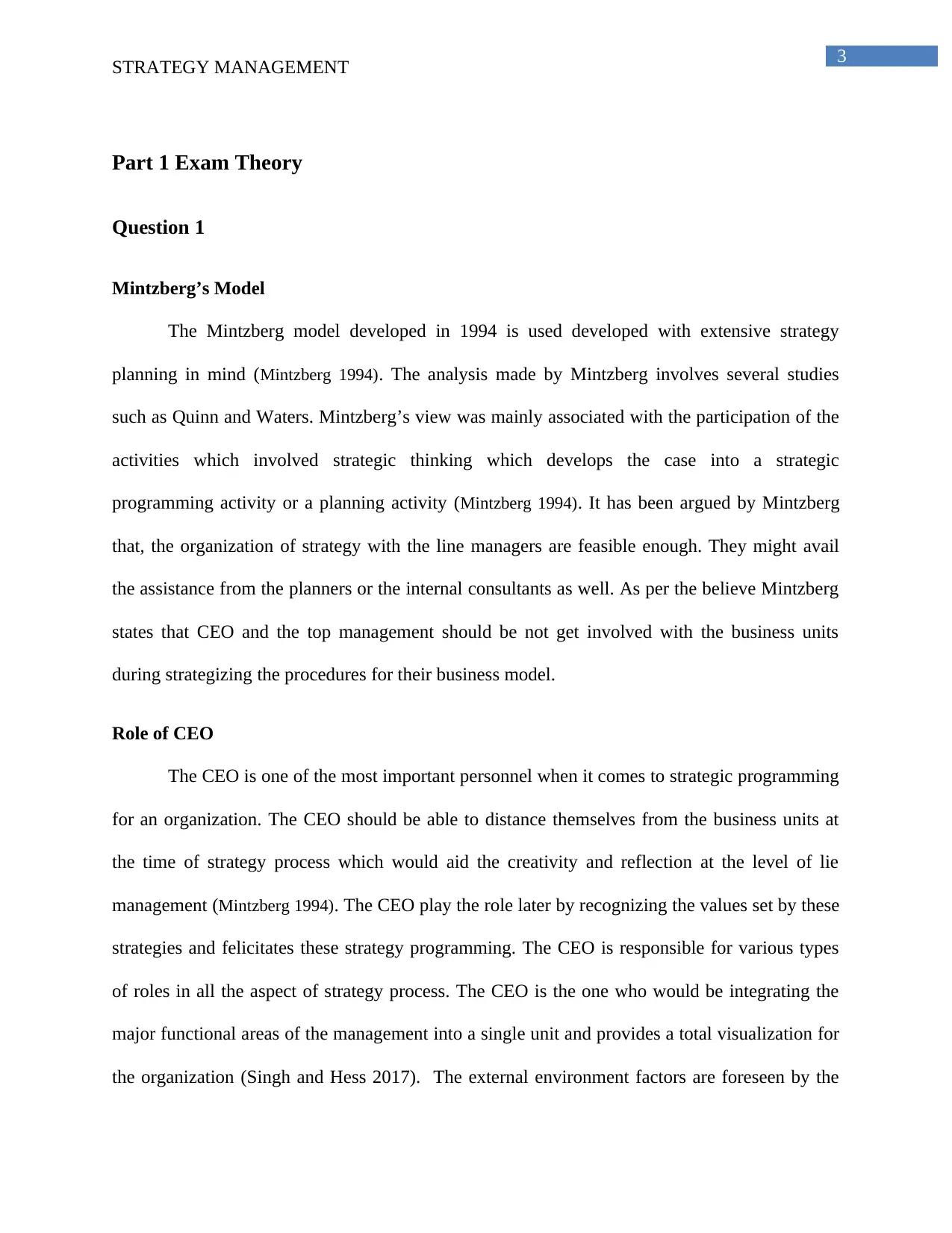
3
STRATEGY MANAGEMENT
Part 1 Exam Theory
Question 1
Mintzberg’s Model
The Mintzberg model developed in 1994 is used developed with extensive strategy
planning in mind (Mintzberg 1994). The analysis made by Mintzberg involves several studies
such as Quinn and Waters. Mintzberg’s view was mainly associated with the participation of the
activities which involved strategic thinking which develops the case into a strategic
programming activity or a planning activity (Mintzberg 1994). It has been argued by Mintzberg
that, the organization of strategy with the line managers are feasible enough. They might avail
the assistance from the planners or the internal consultants as well. As per the believe Mintzberg
states that CEO and the top management should be not get involved with the business units
during strategizing the procedures for their business model.
Role of CEO
The CEO is one of the most important personnel when it comes to strategic programming
for an organization. The CEO should be able to distance themselves from the business units at
the time of strategy process which would aid the creativity and reflection at the level of lie
management (Mintzberg 1994). The CEO play the role later by recognizing the values set by these
strategies and felicitates these strategy programming. The CEO is responsible for various types
of roles in all the aspect of strategy process. The CEO is the one who would be integrating the
major functional areas of the management into a single unit and provides a total visualization for
the organization (Singh and Hess 2017). The external environment factors are foreseen by the
STRATEGY MANAGEMENT
Part 1 Exam Theory
Question 1
Mintzberg’s Model
The Mintzberg model developed in 1994 is used developed with extensive strategy
planning in mind (Mintzberg 1994). The analysis made by Mintzberg involves several studies
such as Quinn and Waters. Mintzberg’s view was mainly associated with the participation of the
activities which involved strategic thinking which develops the case into a strategic
programming activity or a planning activity (Mintzberg 1994). It has been argued by Mintzberg
that, the organization of strategy with the line managers are feasible enough. They might avail
the assistance from the planners or the internal consultants as well. As per the believe Mintzberg
states that CEO and the top management should be not get involved with the business units
during strategizing the procedures for their business model.
Role of CEO
The CEO is one of the most important personnel when it comes to strategic programming
for an organization. The CEO should be able to distance themselves from the business units at
the time of strategy process which would aid the creativity and reflection at the level of lie
management (Mintzberg 1994). The CEO play the role later by recognizing the values set by these
strategies and felicitates these strategy programming. The CEO is responsible for various types
of roles in all the aspect of strategy process. The CEO is the one who would be integrating the
major functional areas of the management into a single unit and provides a total visualization for
the organization (Singh and Hess 2017). The external environment factors are foreseen by the
Paraphrase This Document
Need a fresh take? Get an instant paraphrase of this document with our AI Paraphraser
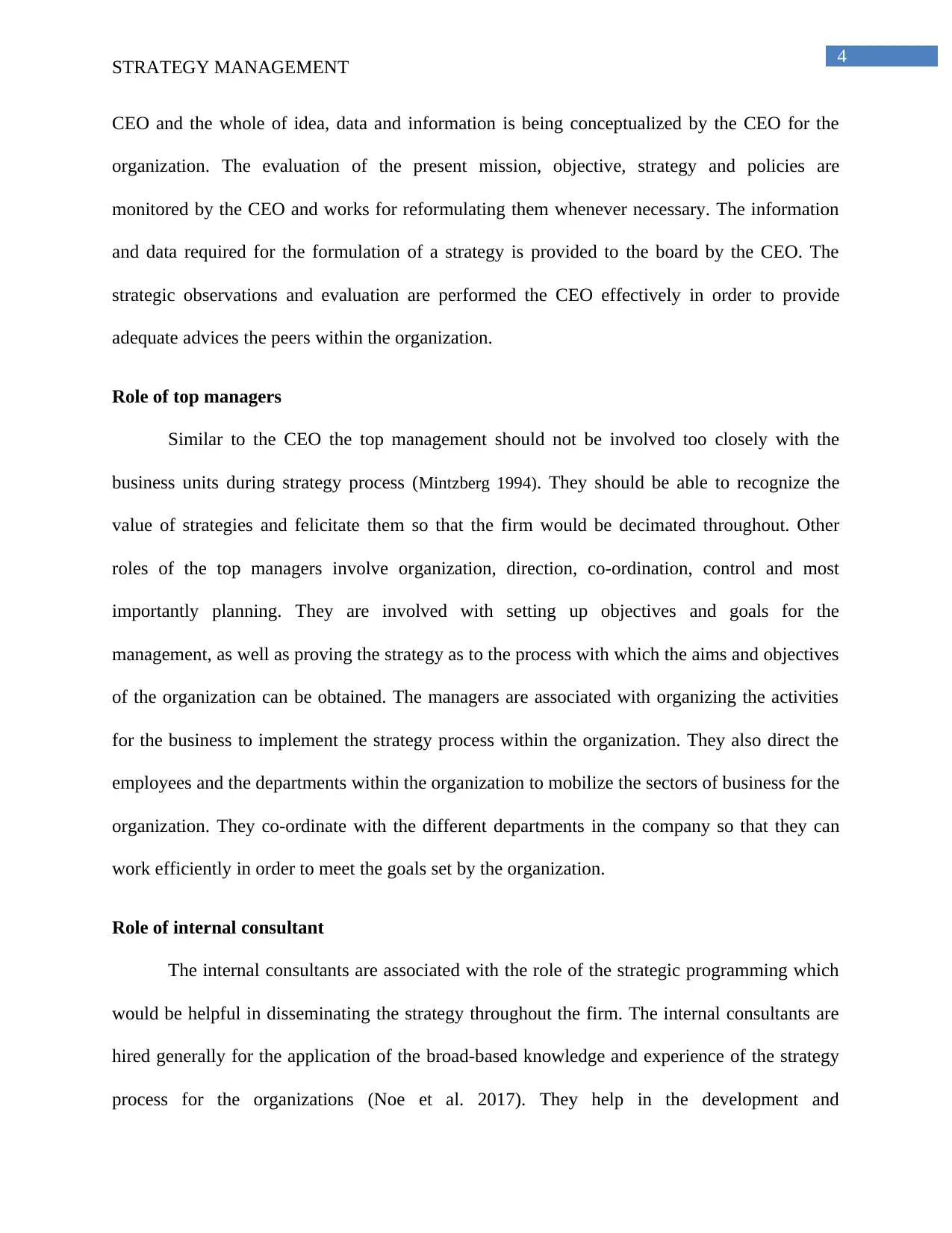
4
STRATEGY MANAGEMENT
CEO and the whole of idea, data and information is being conceptualized by the CEO for the
organization. The evaluation of the present mission, objective, strategy and policies are
monitored by the CEO and works for reformulating them whenever necessary. The information
and data required for the formulation of a strategy is provided to the board by the CEO. The
strategic observations and evaluation are performed the CEO effectively in order to provide
adequate advices the peers within the organization.
Role of top managers
Similar to the CEO the top management should not be involved too closely with the
business units during strategy process (Mintzberg 1994). They should be able to recognize the
value of strategies and felicitate them so that the firm would be decimated throughout. Other
roles of the top managers involve organization, direction, co-ordination, control and most
importantly planning. They are involved with setting up objectives and goals for the
management, as well as proving the strategy as to the process with which the aims and objectives
of the organization can be obtained. The managers are associated with organizing the activities
for the business to implement the strategy process within the organization. They also direct the
employees and the departments within the organization to mobilize the sectors of business for the
organization. They co-ordinate with the different departments in the company so that they can
work efficiently in order to meet the goals set by the organization.
Role of internal consultant
The internal consultants are associated with the role of the strategic programming which
would be helpful in disseminating the strategy throughout the firm. The internal consultants are
hired generally for the application of the broad-based knowledge and experience of the strategy
process for the organizations (Noe et al. 2017). They help in the development and
STRATEGY MANAGEMENT
CEO and the whole of idea, data and information is being conceptualized by the CEO for the
organization. The evaluation of the present mission, objective, strategy and policies are
monitored by the CEO and works for reformulating them whenever necessary. The information
and data required for the formulation of a strategy is provided to the board by the CEO. The
strategic observations and evaluation are performed the CEO effectively in order to provide
adequate advices the peers within the organization.
Role of top managers
Similar to the CEO the top management should not be involved too closely with the
business units during strategy process (Mintzberg 1994). They should be able to recognize the
value of strategies and felicitate them so that the firm would be decimated throughout. Other
roles of the top managers involve organization, direction, co-ordination, control and most
importantly planning. They are involved with setting up objectives and goals for the
management, as well as proving the strategy as to the process with which the aims and objectives
of the organization can be obtained. The managers are associated with organizing the activities
for the business to implement the strategy process within the organization. They also direct the
employees and the departments within the organization to mobilize the sectors of business for the
organization. They co-ordinate with the different departments in the company so that they can
work efficiently in order to meet the goals set by the organization.
Role of internal consultant
The internal consultants are associated with the role of the strategic programming which
would be helpful in disseminating the strategy throughout the firm. The internal consultants are
hired generally for the application of the broad-based knowledge and experience of the strategy
process for the organizations (Noe et al. 2017). They help in the development and
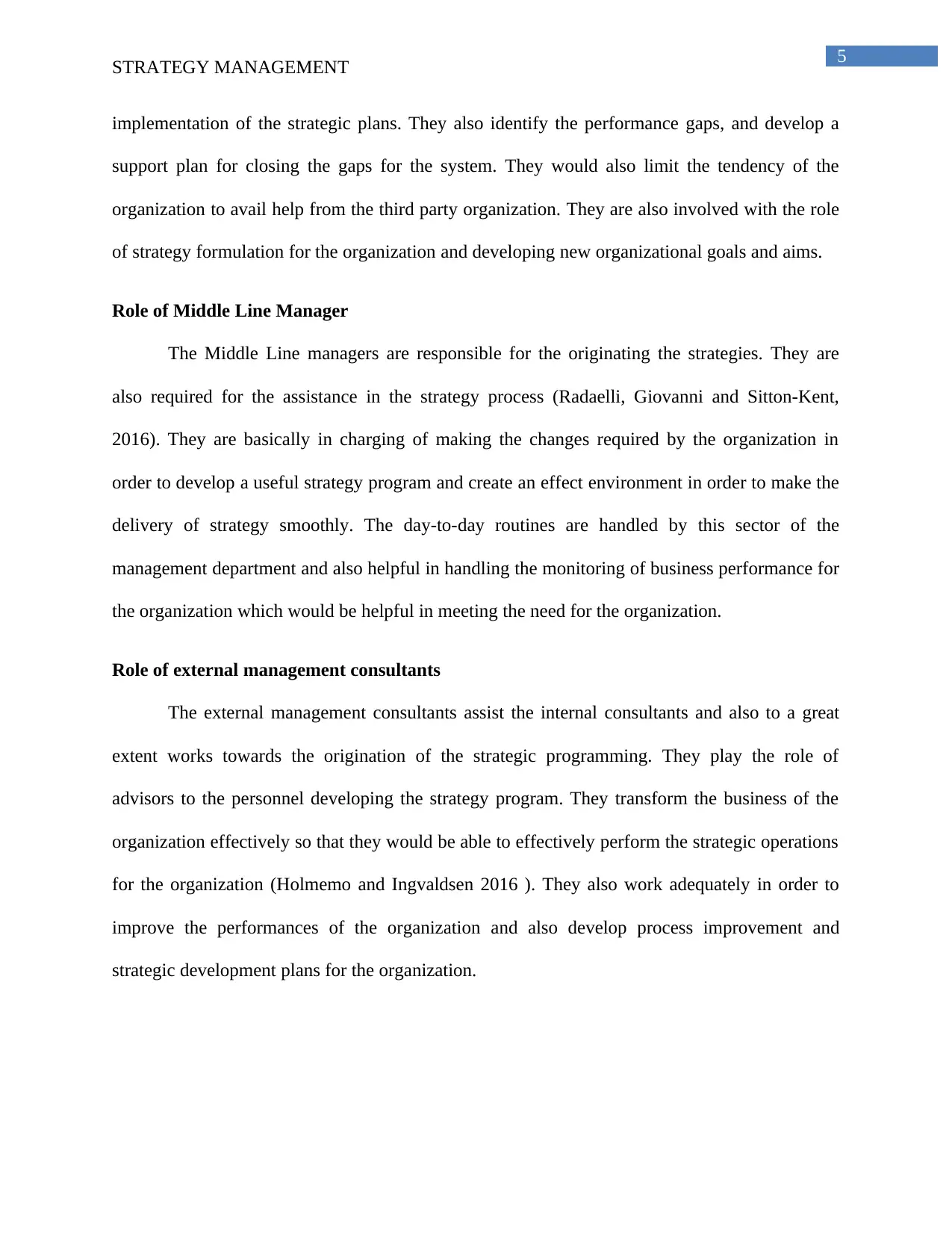
5
STRATEGY MANAGEMENT
implementation of the strategic plans. They also identify the performance gaps, and develop a
support plan for closing the gaps for the system. They would also limit the tendency of the
organization to avail help from the third party organization. They are also involved with the role
of strategy formulation for the organization and developing new organizational goals and aims.
Role of Middle Line Manager
The Middle Line managers are responsible for the originating the strategies. They are
also required for the assistance in the strategy process (Radaelli, Giovanni and Sitton-Kent,
2016). They are basically in charging of making the changes required by the organization in
order to develop a useful strategy program and create an effect environment in order to make the
delivery of strategy smoothly. The day-to-day routines are handled by this sector of the
management department and also helpful in handling the monitoring of business performance for
the organization which would be helpful in meeting the need for the organization.
Role of external management consultants
The external management consultants assist the internal consultants and also to a great
extent works towards the origination of the strategic programming. They play the role of
advisors to the personnel developing the strategy program. They transform the business of the
organization effectively so that they would be able to effectively perform the strategic operations
for the organization (Holmemo and Ingvaldsen 2016 ). They also work adequately in order to
improve the performances of the organization and also develop process improvement and
strategic development plans for the organization.
STRATEGY MANAGEMENT
implementation of the strategic plans. They also identify the performance gaps, and develop a
support plan for closing the gaps for the system. They would also limit the tendency of the
organization to avail help from the third party organization. They are also involved with the role
of strategy formulation for the organization and developing new organizational goals and aims.
Role of Middle Line Manager
The Middle Line managers are responsible for the originating the strategies. They are
also required for the assistance in the strategy process (Radaelli, Giovanni and Sitton-Kent,
2016). They are basically in charging of making the changes required by the organization in
order to develop a useful strategy program and create an effect environment in order to make the
delivery of strategy smoothly. The day-to-day routines are handled by this sector of the
management department and also helpful in handling the monitoring of business performance for
the organization which would be helpful in meeting the need for the organization.
Role of external management consultants
The external management consultants assist the internal consultants and also to a great
extent works towards the origination of the strategic programming. They play the role of
advisors to the personnel developing the strategy program. They transform the business of the
organization effectively so that they would be able to effectively perform the strategic operations
for the organization (Holmemo and Ingvaldsen 2016 ). They also work adequately in order to
improve the performances of the organization and also develop process improvement and
strategic development plans for the organization.
⊘ This is a preview!⊘
Do you want full access?
Subscribe today to unlock all pages.

Trusted by 1+ million students worldwide
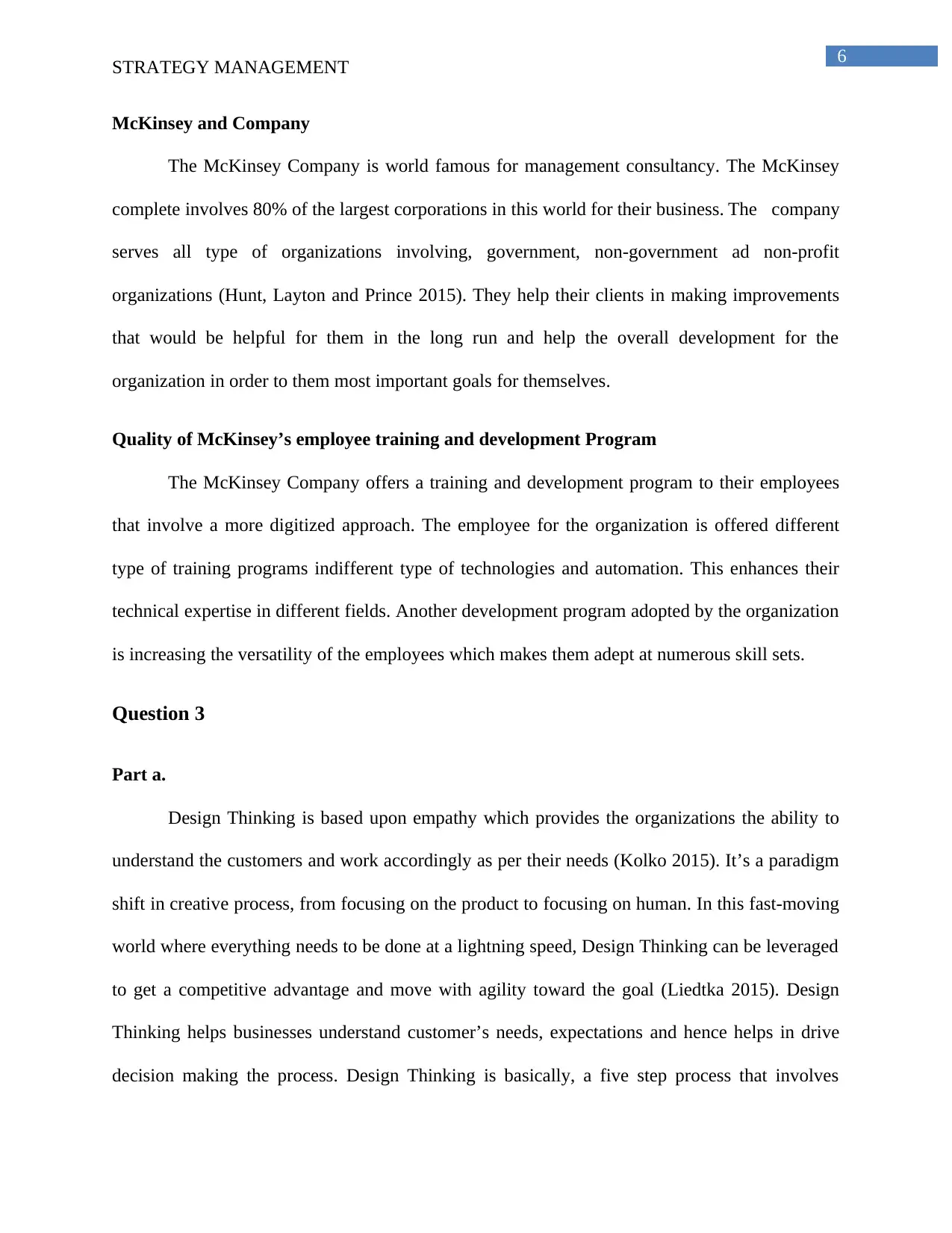
6
STRATEGY MANAGEMENT
McKinsey and Company
The McKinsey Company is world famous for management consultancy. The McKinsey
complete involves 80% of the largest corporations in this world for their business. The company
serves all type of organizations involving, government, non-government ad non-profit
organizations (Hunt, Layton and Prince 2015). They help their clients in making improvements
that would be helpful for them in the long run and help the overall development for the
organization in order to them most important goals for themselves.
Quality of McKinsey’s employee training and development Program
The McKinsey Company offers a training and development program to their employees
that involve a more digitized approach. The employee for the organization is offered different
type of training programs indifferent type of technologies and automation. This enhances their
technical expertise in different fields. Another development program adopted by the organization
is increasing the versatility of the employees which makes them adept at numerous skill sets.
Question 3
Part a.
Design Thinking is based upon empathy which provides the organizations the ability to
understand the customers and work accordingly as per their needs (Kolko 2015). It’s a paradigm
shift in creative process, from focusing on the product to focusing on human. In this fast-moving
world where everything needs to be done at a lightning speed, Design Thinking can be leveraged
to get a competitive advantage and move with agility toward the goal (Liedtka 2015). Design
Thinking helps businesses understand customer’s needs, expectations and hence helps in drive
decision making the process. Design Thinking is basically, a five step process that involves
STRATEGY MANAGEMENT
McKinsey and Company
The McKinsey Company is world famous for management consultancy. The McKinsey
complete involves 80% of the largest corporations in this world for their business. The company
serves all type of organizations involving, government, non-government ad non-profit
organizations (Hunt, Layton and Prince 2015). They help their clients in making improvements
that would be helpful for them in the long run and help the overall development for the
organization in order to them most important goals for themselves.
Quality of McKinsey’s employee training and development Program
The McKinsey Company offers a training and development program to their employees
that involve a more digitized approach. The employee for the organization is offered different
type of training programs indifferent type of technologies and automation. This enhances their
technical expertise in different fields. Another development program adopted by the organization
is increasing the versatility of the employees which makes them adept at numerous skill sets.
Question 3
Part a.
Design Thinking is based upon empathy which provides the organizations the ability to
understand the customers and work accordingly as per their needs (Kolko 2015). It’s a paradigm
shift in creative process, from focusing on the product to focusing on human. In this fast-moving
world where everything needs to be done at a lightning speed, Design Thinking can be leveraged
to get a competitive advantage and move with agility toward the goal (Liedtka 2015). Design
Thinking helps businesses understand customer’s needs, expectations and hence helps in drive
decision making the process. Design Thinking is basically, a five step process that involves
Paraphrase This Document
Need a fresh take? Get an instant paraphrase of this document with our AI Paraphraser
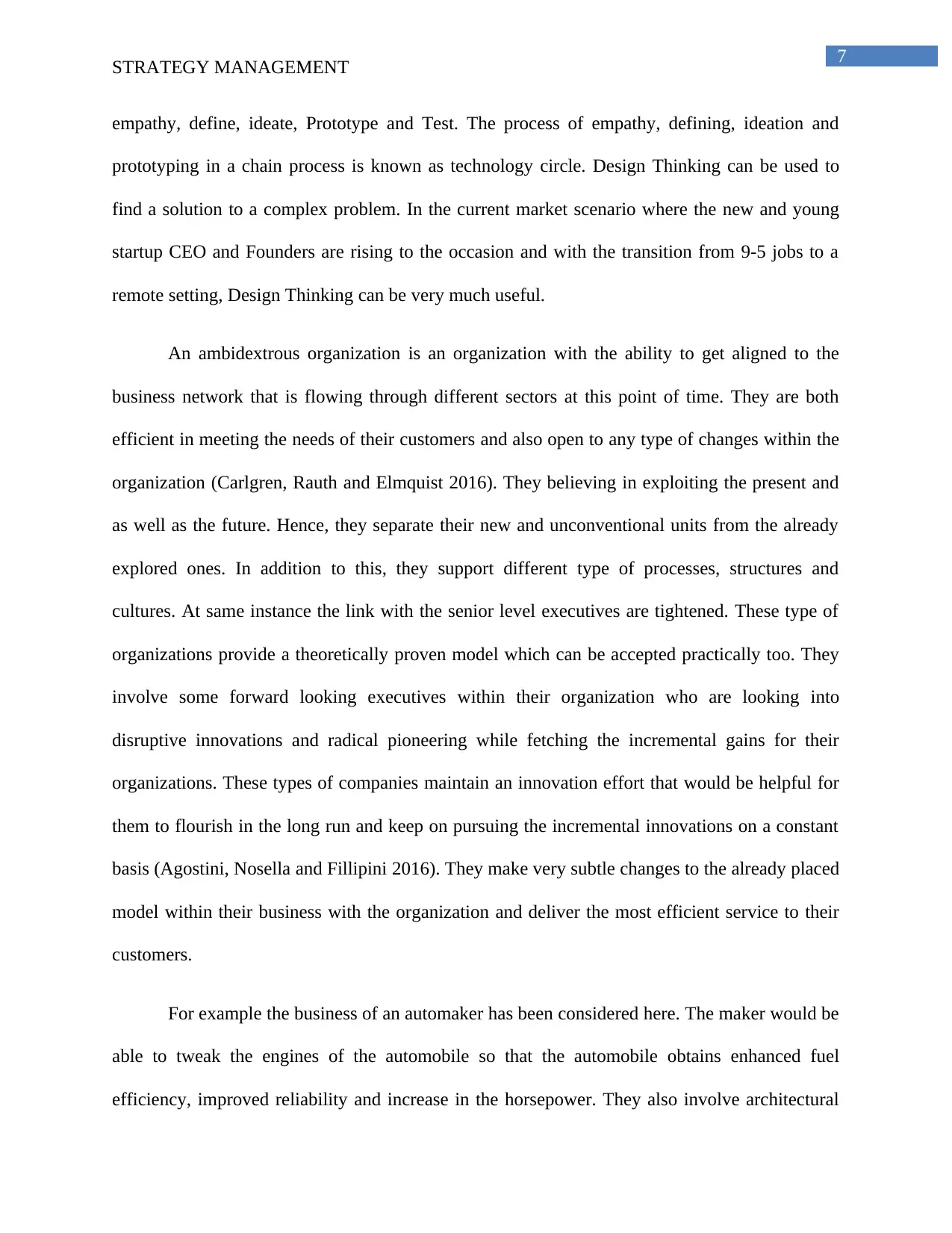
7
STRATEGY MANAGEMENT
empathy, define, ideate, Prototype and Test. The process of empathy, defining, ideation and
prototyping in a chain process is known as technology circle. Design Thinking can be used to
find a solution to a complex problem. In the current market scenario where the new and young
startup CEO and Founders are rising to the occasion and with the transition from 9-5 jobs to a
remote setting, Design Thinking can be very much useful.
An ambidextrous organization is an organization with the ability to get aligned to the
business network that is flowing through different sectors at this point of time. They are both
efficient in meeting the needs of their customers and also open to any type of changes within the
organization (Carlgren, Rauth and Elmquist 2016). They believing in exploiting the present and
as well as the future. Hence, they separate their new and unconventional units from the already
explored ones. In addition to this, they support different type of processes, structures and
cultures. At same instance the link with the senior level executives are tightened. These type of
organizations provide a theoretically proven model which can be accepted practically too. They
involve some forward looking executives within their organization who are looking into
disruptive innovations and radical pioneering while fetching the incremental gains for their
organizations. These types of companies maintain an innovation effort that would be helpful for
them to flourish in the long run and keep on pursuing the incremental innovations on a constant
basis (Agostini, Nosella and Fillipini 2016). They make very subtle changes to the already placed
model within their business with the organization and deliver the most efficient service to their
customers.
For example the business of an automaker has been considered here. The maker would be
able to tweak the engines of the automobile so that the automobile obtains enhanced fuel
efficiency, improved reliability and increase in the horsepower. They also involve architectural
STRATEGY MANAGEMENT
empathy, define, ideate, Prototype and Test. The process of empathy, defining, ideation and
prototyping in a chain process is known as technology circle. Design Thinking can be used to
find a solution to a complex problem. In the current market scenario where the new and young
startup CEO and Founders are rising to the occasion and with the transition from 9-5 jobs to a
remote setting, Design Thinking can be very much useful.
An ambidextrous organization is an organization with the ability to get aligned to the
business network that is flowing through different sectors at this point of time. They are both
efficient in meeting the needs of their customers and also open to any type of changes within the
organization (Carlgren, Rauth and Elmquist 2016). They believing in exploiting the present and
as well as the future. Hence, they separate their new and unconventional units from the already
explored ones. In addition to this, they support different type of processes, structures and
cultures. At same instance the link with the senior level executives are tightened. These type of
organizations provide a theoretically proven model which can be accepted practically too. They
involve some forward looking executives within their organization who are looking into
disruptive innovations and radical pioneering while fetching the incremental gains for their
organizations. These types of companies maintain an innovation effort that would be helpful for
them to flourish in the long run and keep on pursuing the incremental innovations on a constant
basis (Agostini, Nosella and Fillipini 2016). They make very subtle changes to the already placed
model within their business with the organization and deliver the most efficient service to their
customers.
For example the business of an automaker has been considered here. The maker would be
able to tweak the engines of the automobile so that the automobile obtains enhanced fuel
efficiency, improved reliability and increase in the horsepower. They also involve architectural
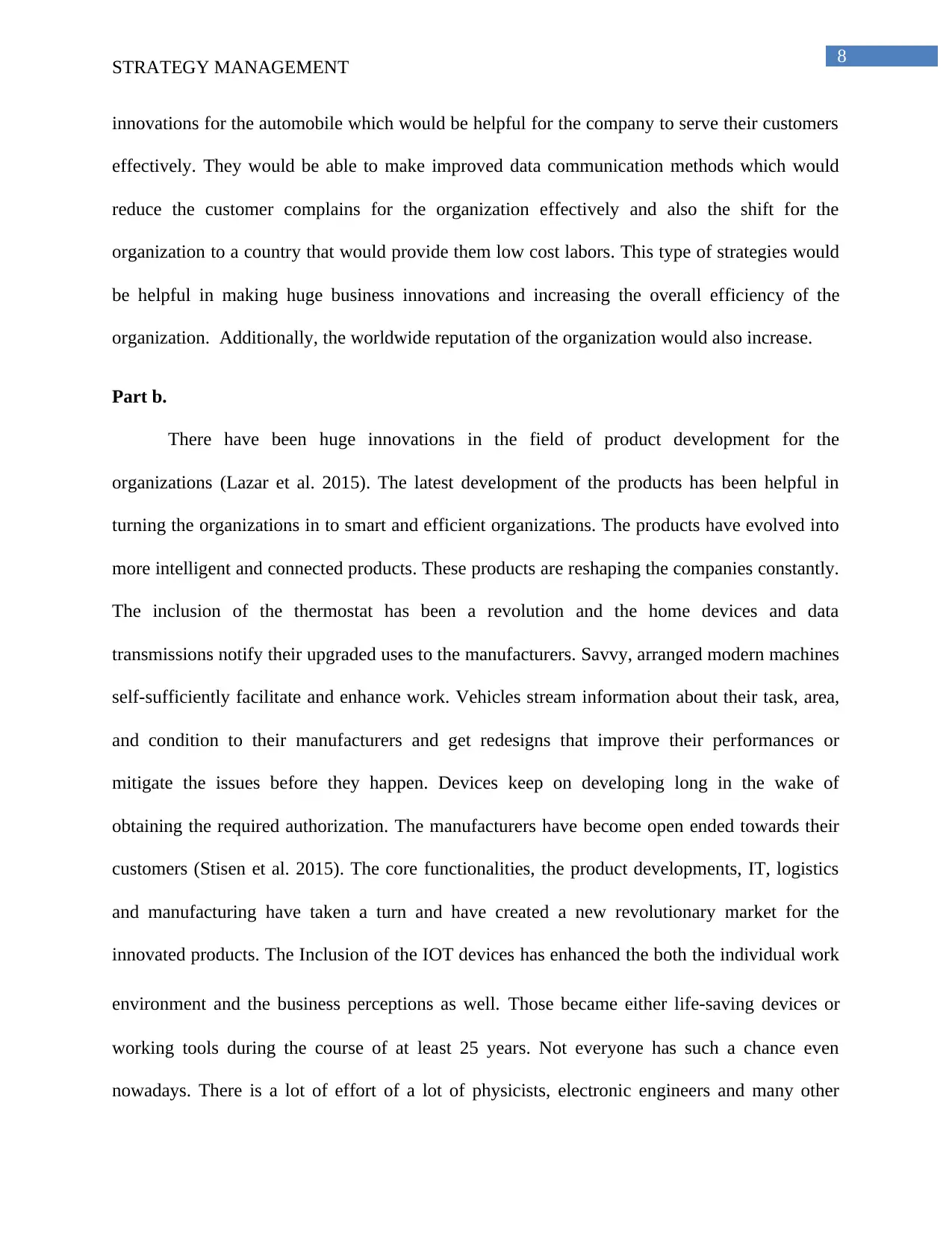
8
STRATEGY MANAGEMENT
innovations for the automobile which would be helpful for the company to serve their customers
effectively. They would be able to make improved data communication methods which would
reduce the customer complains for the organization effectively and also the shift for the
organization to a country that would provide them low cost labors. This type of strategies would
be helpful in making huge business innovations and increasing the overall efficiency of the
organization. Additionally, the worldwide reputation of the organization would also increase.
Part b.
There have been huge innovations in the field of product development for the
organizations (Lazar et al. 2015). The latest development of the products has been helpful in
turning the organizations in to smart and efficient organizations. The products have evolved into
more intelligent and connected products. These products are reshaping the companies constantly.
The inclusion of the thermostat has been a revolution and the home devices and data
transmissions notify their upgraded uses to the manufacturers. Savvy, arranged modern machines
self-sufficiently facilitate and enhance work. Vehicles stream information about their task, area,
and condition to their manufacturers and get redesigns that improve their performances or
mitigate the issues before they happen. Devices keep on developing long in the wake of
obtaining the required authorization. The manufacturers have become open ended towards their
customers (Stisen et al. 2015). The core functionalities, the product developments, IT, logistics
and manufacturing have taken a turn and have created a new revolutionary market for the
innovated products. The Inclusion of the IOT devices has enhanced the both the individual work
environment and the business perceptions as well. Those became either life-saving devices or
working tools during the course of at least 25 years. Not everyone has such a chance even
nowadays. There is a lot of effort of a lot of physicists, electronic engineers and many other
STRATEGY MANAGEMENT
innovations for the automobile which would be helpful for the company to serve their customers
effectively. They would be able to make improved data communication methods which would
reduce the customer complains for the organization effectively and also the shift for the
organization to a country that would provide them low cost labors. This type of strategies would
be helpful in making huge business innovations and increasing the overall efficiency of the
organization. Additionally, the worldwide reputation of the organization would also increase.
Part b.
There have been huge innovations in the field of product development for the
organizations (Lazar et al. 2015). The latest development of the products has been helpful in
turning the organizations in to smart and efficient organizations. The products have evolved into
more intelligent and connected products. These products are reshaping the companies constantly.
The inclusion of the thermostat has been a revolution and the home devices and data
transmissions notify their upgraded uses to the manufacturers. Savvy, arranged modern machines
self-sufficiently facilitate and enhance work. Vehicles stream information about their task, area,
and condition to their manufacturers and get redesigns that improve their performances or
mitigate the issues before they happen. Devices keep on developing long in the wake of
obtaining the required authorization. The manufacturers have become open ended towards their
customers (Stisen et al. 2015). The core functionalities, the product developments, IT, logistics
and manufacturing have taken a turn and have created a new revolutionary market for the
innovated products. The Inclusion of the IOT devices has enhanced the both the individual work
environment and the business perceptions as well. Those became either life-saving devices or
working tools during the course of at least 25 years. Not everyone has such a chance even
nowadays. There is a lot of effort of a lot of physicists, electronic engineers and many other
⊘ This is a preview!⊘
Do you want full access?
Subscribe today to unlock all pages.

Trusted by 1+ million students worldwide
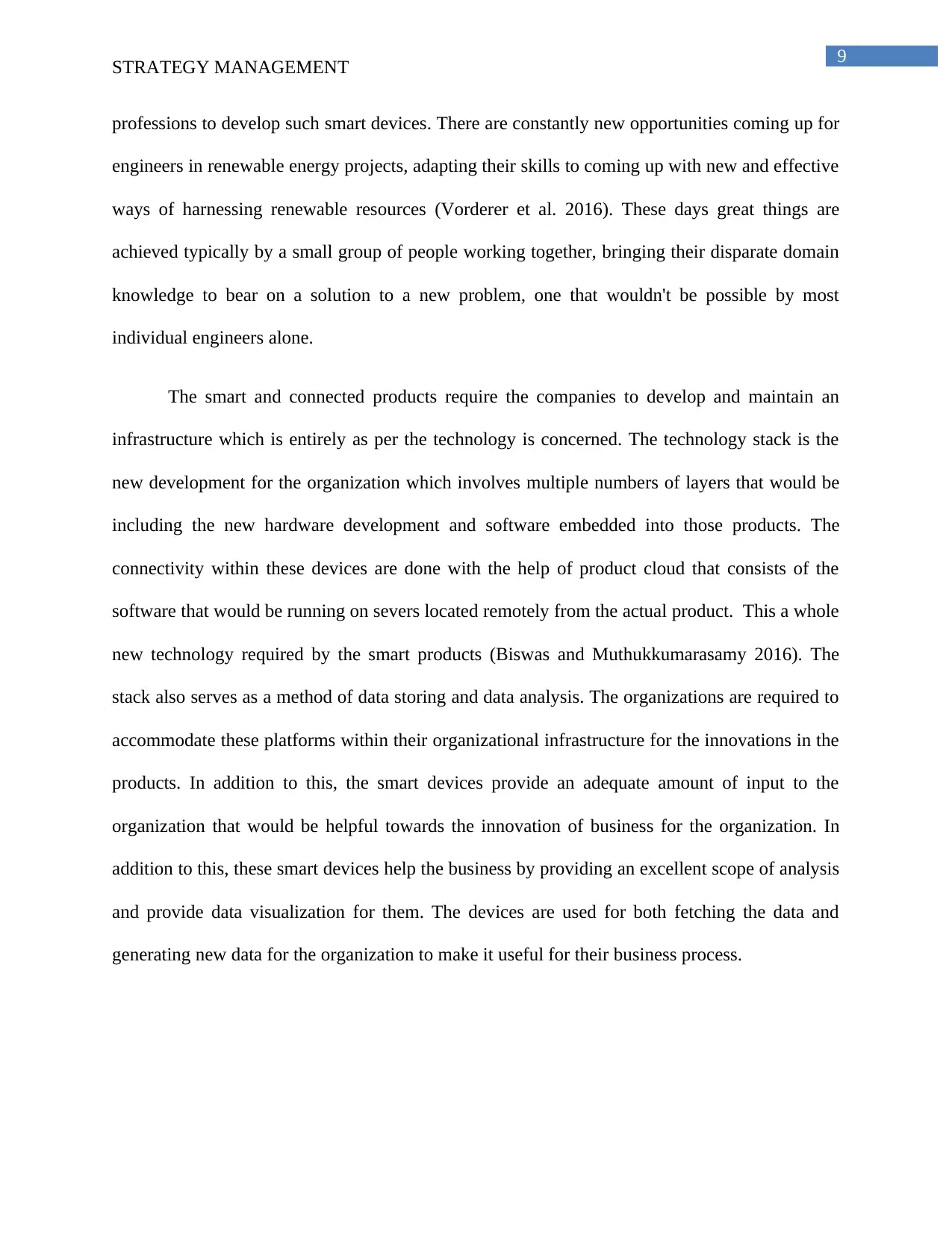
9
STRATEGY MANAGEMENT
professions to develop such smart devices. There are constantly new opportunities coming up for
engineers in renewable energy projects, adapting their skills to coming up with new and effective
ways of harnessing renewable resources (Vorderer et al. 2016). These days great things are
achieved typically by a small group of people working together, bringing their disparate domain
knowledge to bear on a solution to a new problem, one that wouldn't be possible by most
individual engineers alone.
The smart and connected products require the companies to develop and maintain an
infrastructure which is entirely as per the technology is concerned. The technology stack is the
new development for the organization which involves multiple numbers of layers that would be
including the new hardware development and software embedded into those products. The
connectivity within these devices are done with the help of product cloud that consists of the
software that would be running on severs located remotely from the actual product. This a whole
new technology required by the smart products (Biswas and Muthukkumarasamy 2016). The
stack also serves as a method of data storing and data analysis. The organizations are required to
accommodate these platforms within their organizational infrastructure for the innovations in the
products. In addition to this, the smart devices provide an adequate amount of input to the
organization that would be helpful towards the innovation of business for the organization. In
addition to this, these smart devices help the business by providing an excellent scope of analysis
and provide data visualization for them. The devices are used for both fetching the data and
generating new data for the organization to make it useful for their business process.
STRATEGY MANAGEMENT
professions to develop such smart devices. There are constantly new opportunities coming up for
engineers in renewable energy projects, adapting their skills to coming up with new and effective
ways of harnessing renewable resources (Vorderer et al. 2016). These days great things are
achieved typically by a small group of people working together, bringing their disparate domain
knowledge to bear on a solution to a new problem, one that wouldn't be possible by most
individual engineers alone.
The smart and connected products require the companies to develop and maintain an
infrastructure which is entirely as per the technology is concerned. The technology stack is the
new development for the organization which involves multiple numbers of layers that would be
including the new hardware development and software embedded into those products. The
connectivity within these devices are done with the help of product cloud that consists of the
software that would be running on severs located remotely from the actual product. This a whole
new technology required by the smart products (Biswas and Muthukkumarasamy 2016). The
stack also serves as a method of data storing and data analysis. The organizations are required to
accommodate these platforms within their organizational infrastructure for the innovations in the
products. In addition to this, the smart devices provide an adequate amount of input to the
organization that would be helpful towards the innovation of business for the organization. In
addition to this, these smart devices help the business by providing an excellent scope of analysis
and provide data visualization for them. The devices are used for both fetching the data and
generating new data for the organization to make it useful for their business process.
Paraphrase This Document
Need a fresh take? Get an instant paraphrase of this document with our AI Paraphraser
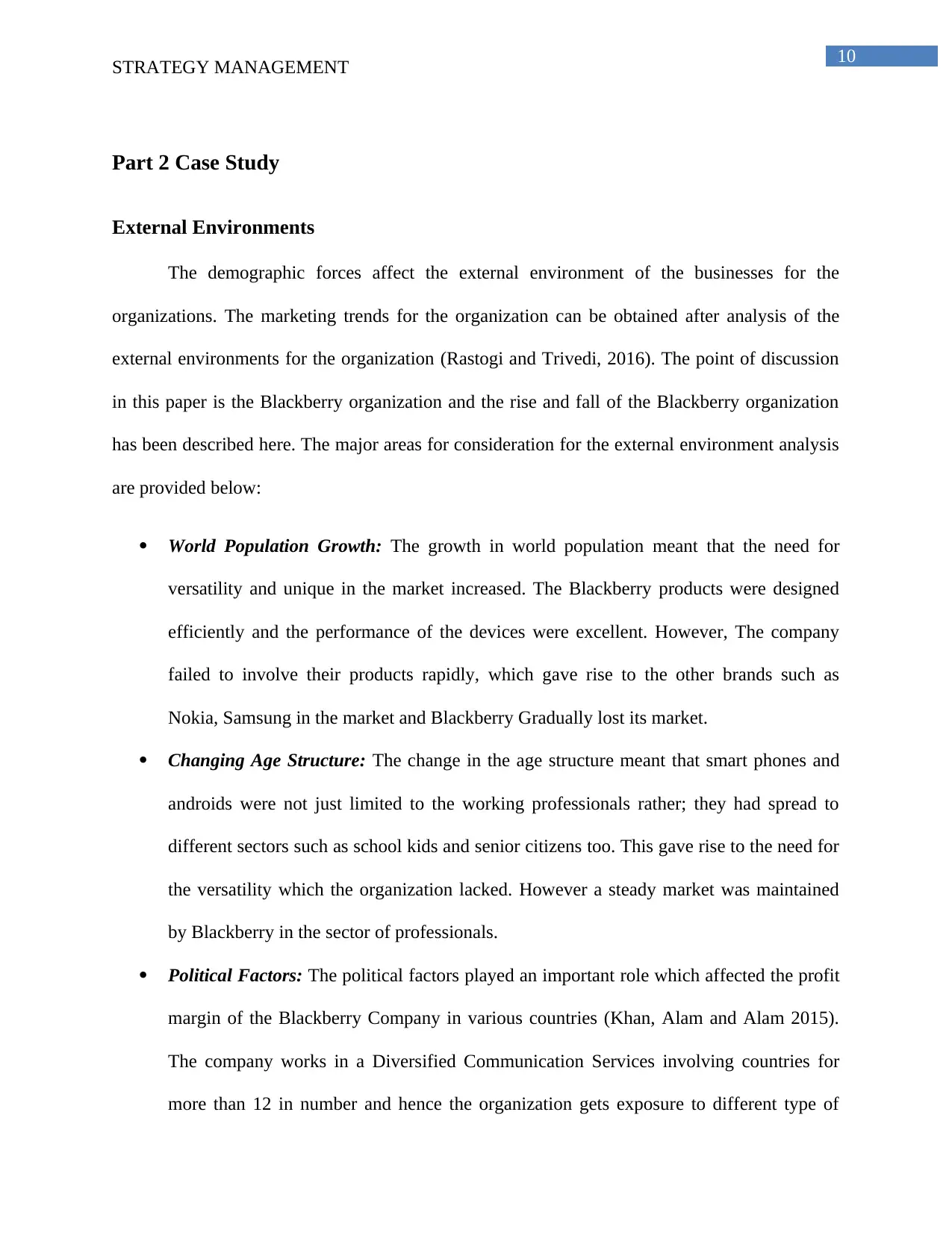
10
STRATEGY MANAGEMENT
Part 2 Case Study
External Environments
The demographic forces affect the external environment of the businesses for the
organizations. The marketing trends for the organization can be obtained after analysis of the
external environments for the organization (Rastogi and Trivedi, 2016). The point of discussion
in this paper is the Blackberry organization and the rise and fall of the Blackberry organization
has been described here. The major areas for consideration for the external environment analysis
are provided below:
World Population Growth: The growth in world population meant that the need for
versatility and unique in the market increased. The Blackberry products were designed
efficiently and the performance of the devices were excellent. However, The company
failed to involve their products rapidly, which gave rise to the other brands such as
Nokia, Samsung in the market and Blackberry Gradually lost its market.
Changing Age Structure: The change in the age structure meant that smart phones and
androids were not just limited to the working professionals rather; they had spread to
different sectors such as school kids and senior citizens too. This gave rise to the need for
the versatility which the organization lacked. However a steady market was maintained
by Blackberry in the sector of professionals.
Political Factors: The political factors played an important role which affected the profit
margin of the Blackberry Company in various countries (Khan, Alam and Alam 2015).
The company works in a Diversified Communication Services involving countries for
more than 12 in number and hence the organization gets exposure to different type of
STRATEGY MANAGEMENT
Part 2 Case Study
External Environments
The demographic forces affect the external environment of the businesses for the
organizations. The marketing trends for the organization can be obtained after analysis of the
external environments for the organization (Rastogi and Trivedi, 2016). The point of discussion
in this paper is the Blackberry organization and the rise and fall of the Blackberry organization
has been described here. The major areas for consideration for the external environment analysis
are provided below:
World Population Growth: The growth in world population meant that the need for
versatility and unique in the market increased. The Blackberry products were designed
efficiently and the performance of the devices were excellent. However, The company
failed to involve their products rapidly, which gave rise to the other brands such as
Nokia, Samsung in the market and Blackberry Gradually lost its market.
Changing Age Structure: The change in the age structure meant that smart phones and
androids were not just limited to the working professionals rather; they had spread to
different sectors such as school kids and senior citizens too. This gave rise to the need for
the versatility which the organization lacked. However a steady market was maintained
by Blackberry in the sector of professionals.
Political Factors: The political factors played an important role which affected the profit
margin of the Blackberry Company in various countries (Khan, Alam and Alam 2015).
The company works in a Diversified Communication Services involving countries for
more than 12 in number and hence the organization gets exposure to different type of
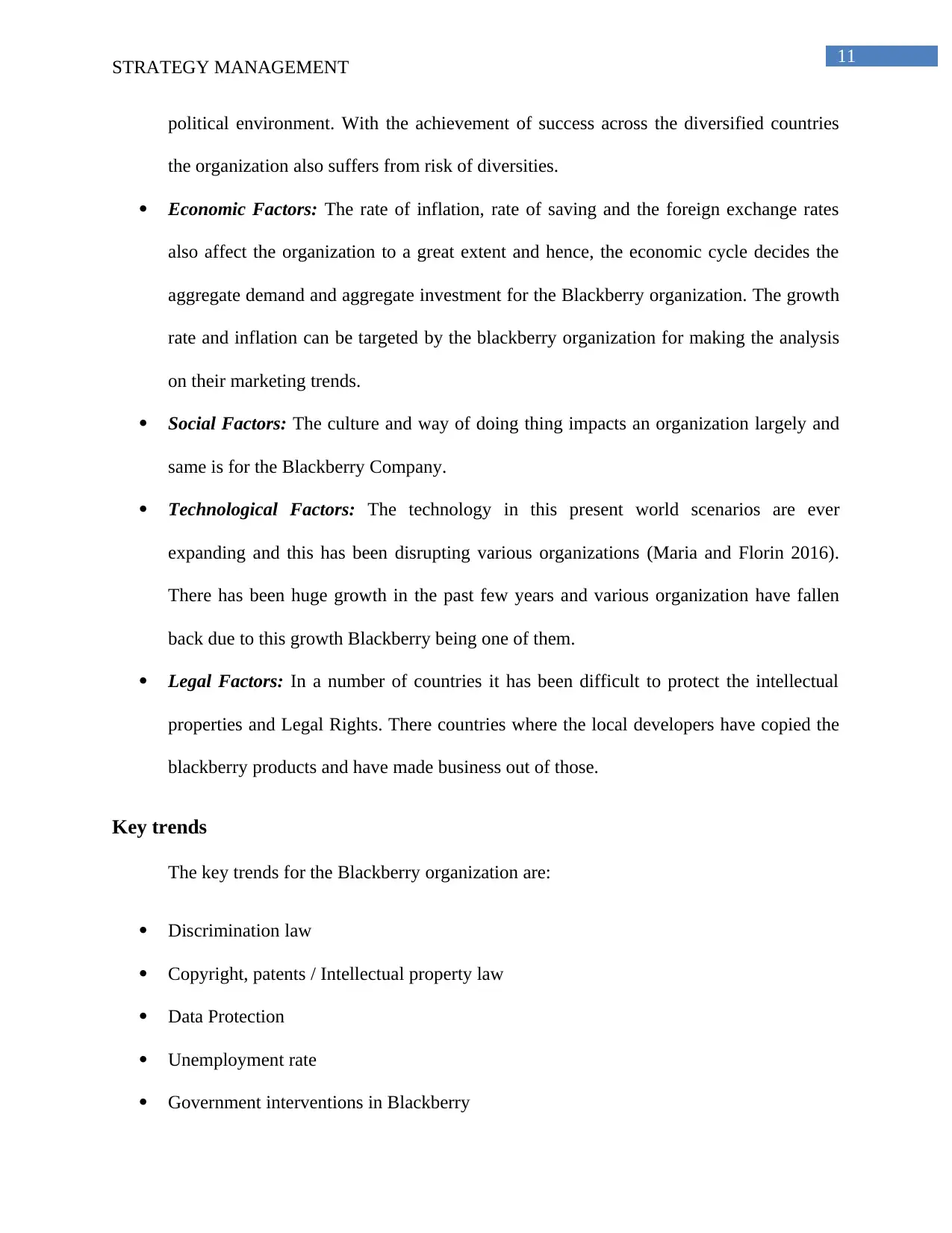
11
STRATEGY MANAGEMENT
political environment. With the achievement of success across the diversified countries
the organization also suffers from risk of diversities.
Economic Factors: The rate of inflation, rate of saving and the foreign exchange rates
also affect the organization to a great extent and hence, the economic cycle decides the
aggregate demand and aggregate investment for the Blackberry organization. The growth
rate and inflation can be targeted by the blackberry organization for making the analysis
on their marketing trends.
Social Factors: The culture and way of doing thing impacts an organization largely and
same is for the Blackberry Company.
Technological Factors: The technology in this present world scenarios are ever
expanding and this has been disrupting various organizations (Maria and Florin 2016).
There has been huge growth in the past few years and various organization have fallen
back due to this growth Blackberry being one of them.
Legal Factors: In a number of countries it has been difficult to protect the intellectual
properties and Legal Rights. There countries where the local developers have copied the
blackberry products and have made business out of those.
Key trends
The key trends for the Blackberry organization are:
Discrimination law
Copyright, patents / Intellectual property law
Data Protection
Unemployment rate
Government interventions in Blackberry
STRATEGY MANAGEMENT
political environment. With the achievement of success across the diversified countries
the organization also suffers from risk of diversities.
Economic Factors: The rate of inflation, rate of saving and the foreign exchange rates
also affect the organization to a great extent and hence, the economic cycle decides the
aggregate demand and aggregate investment for the Blackberry organization. The growth
rate and inflation can be targeted by the blackberry organization for making the analysis
on their marketing trends.
Social Factors: The culture and way of doing thing impacts an organization largely and
same is for the Blackberry Company.
Technological Factors: The technology in this present world scenarios are ever
expanding and this has been disrupting various organizations (Maria and Florin 2016).
There has been huge growth in the past few years and various organization have fallen
back due to this growth Blackberry being one of them.
Legal Factors: In a number of countries it has been difficult to protect the intellectual
properties and Legal Rights. There countries where the local developers have copied the
blackberry products and have made business out of those.
Key trends
The key trends for the Blackberry organization are:
Discrimination law
Copyright, patents / Intellectual property law
Data Protection
Unemployment rate
Government interventions in Blackberry
⊘ This is a preview!⊘
Do you want full access?
Subscribe today to unlock all pages.

Trusted by 1+ million students worldwide
1 out of 22
Related Documents
Your All-in-One AI-Powered Toolkit for Academic Success.
+13062052269
info@desklib.com
Available 24*7 on WhatsApp / Email
![[object Object]](/_next/static/media/star-bottom.7253800d.svg)
Unlock your academic potential
Copyright © 2020–2025 A2Z Services. All Rights Reserved. Developed and managed by ZUCOL.





